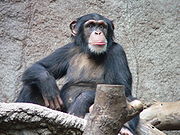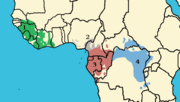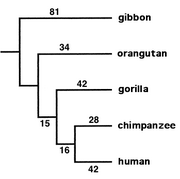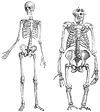Common Chimpanzee
| Common Chimpanzee[1] | ||||||||||||||
|---|---|---|---|---|---|---|---|---|---|---|---|---|---|---|
 |
||||||||||||||
| Conservation status | ||||||||||||||
| Scientific classification | ||||||||||||||
|
||||||||||||||
| Binomial name | ||||||||||||||
| Pan troglodytes (Blumenbach, 1775) |
||||||||||||||
 distribution of Common Chimpanzee. 1. Pan troglodytes verus. 2. P. t. vellerosus. 3. P. t. troglodytes. 4. P. t. schweinfurthii.
|
The Common Chimpanzee (Pan troglodytes), also known as the Robust Chimpanzee, is a great ape. The name troglodytes, Greek for 'cave-dweller', was coined by Johann Friedrich Blumenbach in his Handbuch der Naturgeschichte (Handbook of Natural History) published in 1779. Colloquially, it is often called the chimpanzee (or simply 'chimp'), though technically this term refers to both species in the genus Pan: the Common Chimpanzee and the closely-related Bonobo, or Pygmy Chimpanzee.
Contents |
Subspecies
Several subspecies of the Common Chimpanzee have been recognized:
- Central Chimpanzee, Pan troglodytes troglodytes, in Cameroon, the Central African Republic, Equatorial Guinea, Gabon, the Republic of the Congo, and the Democratic Republic of the Congo;
- Western Chimpanzee, Pan troglodytes verus, in Guinea, Mali, Sierra Leone, Liberia, Côte d'Ivoire, Ghana, and Nigeria;
- Nigeria-Cameroon Chimpanzee, Pan troglodytes vellerosus, in Nigeria and Cameroon;
- Eastern Chimpanzee, Pan troglodytes schweinfurthii, in the Central African Republic, the Sudan, the Democratic Republic of the Congo, Uganda, Rwanda, Burundi, Tanzania, and Zambia.
Basic facts
Common Chimpanzees are found in the tropical forests and wet savannas of Western and Central Africa. They once inhabited most of this region, but their habitat has been dramatically reduced in recent years.
Adults in the wild weigh between 40 and 65 kilograms (88 and 143 lb); males can measure up to 160 centimetres (63 in) and females to 130 cm (51 in), and although lighter than humans they have a pull five to six times stronger.[3] This is because the muscles of the Common Chimpanzee and other primates are far more effective than those of humans.[4] Its body is covered by a coarse dark brown hair, except for the face, fingers, toes, palms of the hands and soles of the feet. Both of its thumbs and its big toes are opposable, allowing a precision grip. Its gestation period is eight months. Infants are weaned when they are about three years old, but usually maintain a close relationship with their mother for several more years; they reach puberty at the age of eight to ten, and their lifespan in captivity is about fifty years.
Diet
Although omnivorous, its diet is mainly vegetarian, consisting of fruits, leaves, nuts, seeds, tubers, and other miscellaneous vegetation, supplemented by insects and small prey. There are also instances of organized hunting; in some cases, such as the killing of Leopard cubs, this primarily seems to be a protective effort, since the Leopard is the main natural predator of the Common Chimpanzee. However, the Common Chimpanzee sometimes band together and hunt Western Red Colobus Monkeys (Piliocolobus badius) for meat. Isolated cases of cannibalism have been documented.
The West African Chimpanzee (Pan troglodytes verus) is the only animal besides humans known to routinely create and use specialized tools specifically for hunting. Chimpanzees near Kédougou, Senegal were observed to create spears by breaking off tree limbs, stripping them of their bark, and sharpening one end with their teeth. They then used these weapons to kill galagos sleeping in hollows.[5]
Behavior
Common Chimpanzees live in communities that typically range from twenty to more than 150 members, but spend most of their time travelling in small parties of just a few individuals. They are both arboreal and terrestrial, spending equal time in the trees and on the ground. Their habitual gait is quadrupedal, using the soles of their feet and resting on their knuckles, but they can walk upright for short distances. Common Chimpanzees are 'knuckle walkers', like gorillas, in contrast to the quadrupedal locomotion of orangutans and bonobos, 'palm walkers' who use the outside edge of their palms.
The Common Chimpanzee lives in a fission-fusion society, where mating is promiscuous, and may be found in groups of the following types: all-male, adult females and offspring, consisting of both sexes, one female and her offspring, or a single individual. At the core of social structures are males, who roam around, protect group members, and search for food. Among males, there is generally a dominance hierarchy. However, this unusual fission-fusion social structure, "in which portions of the parent group may on a regular basis separate from and then rejoin the rest",[6] is highly variable in terms of which particular individual chimpanzees congregate at a given time. This is mainly due to chimpanzees having a high level of individual autonomy within their fission-fusion social groups. Also, communities have large ranges that overlap with those of other groups.
As a result, individual chimpanzees often forage for food alone, or in smaller groups (as opposed to the much larger parent group, which encompasses all the chimpanzees who regularly come into contact and congregate into parties in a particular area). As stated, these smaller groups also emerge in a variety of types, for a variety of purposes. For example, an all-male troop may be organized in order to hunt for meat, while a group consisting of one mature male and one mature female may occur for the purposes of copulation. An individual may encounter certain individuals quite frequently, but have run-ins with others almost never or only in large-scale gatherings. Due to the varying frequency at which chimpanzees associate, the structure of their societies is highly complicated.
When confronted by a predator, chimpanzees will react with loud screams and use any object they can get against the threat. As noted above, the leopard is the chimp's main natural predator, but they have also fallen prey to lions as well.[7]
Tool use
While it has long been known that modern chimpanzees use tools, recent research indicates that chimpanzee stone tool use dates to at least 4300 years ago.[8] A recent study revealed the use of such advanced tools as spears, which West African Chimpanzees in Senegal sharpen with their teeth, being used to spear Senegal Bushbabies out of small holes in trees.[9] An Eastern Chimpanzee has been observed using a modified branch as a tool to capture a squirrel.[10]
Chimpanzee Genome Project

Human and Common Chimpanzee DNA is very similar. After the completion of the Human genome project, a Common Chimpanzee Genome Project was initiated. In December 2003, a preliminary analysis of 7600 genes shared between the two genomes confirmed that certain genes, such as the forkhead-box P2 transcription factor which is involved in speech development, have undergone rapid evolution in the human lineage. A draft version of the chimpanzee genome was published on September 1, 2005, in an article produced by the Chimpanzee Sequencing and Analysis Consortium.[12] The DNA sequence differences between humans and chimpanzees is about thirty-five million single-nucleotide changes, five million insertion/deletion events, and various chromosomal rearrangements. Typical human and chimp protein homologs differ in only an average of two amino acids. About 30% of all human proteins are identical in sequence to the corresponding chimp protein. Duplications of small parts of chromosomes have been the major source of differences between human and chimp genetic material; about 2.7% of the corresponding modern genomes represent differences, produced by gene duplications or deletions, during the approximately four to six million years since humans and chimps diverged from their common evolutionary ancestor. Results from human and chimp genome analyses, currently being conducted by geneticists including David Reich, should help in understanding the genetic basis of some human diseases.
Link with Human Immunodeficiency Virus type 1
Two types of Human Immunodeficiency Virus (HIV) infect humans: HIV-1 and HIV-2. HIV-1 is the more virulent and easily transmitted, and is the source of the majority of HIV infections throughout the world; HIV-2 is largely confined to west Africa.[13] Both types originated in west and central Africa, jumping from primates to humans. HIV-1 has evolved from a Simian Immunodeficiency Virus (SIVcpz) found in the Common Chimpanzee subspecies, Pan troglodytes troglodytes, native to southern Cameroon.[14][15] Kinshasa, in the Democratic Republic of Congo, has the greatest genetic diversity of HIV-1 so far discovered, suggesting that the virus has been there longer than anywhere else. HIV-2 crossed species from a different strain of SIV, found in the Sooty Mangabey, monkeys in Guinea-Bissau.[13]
Divergence from the Bonobo
Recent DNA evidence suggests the Bonobo and Common Chimpanzee species separated from each other less than one million years ago.[16][17] The chimpanzee line split from the last common ancestor of the human line approximately six million years ago. Because no species other than Homo sapiens has survived from the human line of that branching, both chimpanzee species are the closest living relatives of humans.
See also
- Bili Ape
- Great Ape personhood
- Jane Goodall
- List of apes - notable individual apes
- Washoe, Nim Chimpsky
- Theory of mind
References
- ↑ Groves, C. (2005-11-16). Wilson, D. E., and Reeder, D. M. (eds). ed.. Mammal Species of the World (3rd edition ed.). Johns Hopkins University Press. pp. 183. ISBN 0-801-88221-4. http://www.bucknell.edu/msw3/browse.asp?id=12100797.
- ↑ Oates, J.F., Tutin, C.E.G., Humle, T., Wilson, M.L., Baillie, J.E.M., Balmforth, Z., Blom, A., Boesch, C., Cox, D., Davenport, T., Dunn, A., Dupain, J., Duvall, C., Ellis, C.M., Farmer, K.H., Gatti, S., Greengrass, E., Hart, J., Herbinger, I., Hicks, C., Hunt, K.D., Kamenya, S., Maisels, F., Mitani, J.C., Moore, J., Morgan, B.J., Morgan, D.B., Nakamura, M., Nixon, S., Plumptre, A.J., Reynolds, V., Stokes, E.J. & Walsh, P.D. (2007). Pan troglodytes. 2007 IUCN Red List of Threatened Species. IUCN 2007. Retrieved on 2007-09-12. Database entry includes justification for why this species is endangered
- ↑ The Jane Goodall Institute
- ↑ Myosin mutation
- ↑ Pruetz JD, Bertolani P (March 2007). "Savanna chimpanzees, Pan troglodytes verus, hunt with tools". Curr. Biol. 17 (5): 412–7. doi:. PMID 17320393. http://www.current-biology.com/content/article/fulltext?uid=PIIS0960982207008019.
- ↑ Goodall, Jane (1986). The Chimpanzees of Gombe: Patterns of Behavior.
- ↑ Tsukahara T (10 September 1992). "Lions eat chimpanzees: The first evidence of predation by lions on wild chimpanzees". American Journal of Primatology 29 (1): 1–11. doi:.
- ↑ Mercader J, Barton H, Gillespie J, et al (February 2007). "4,300-year-old chimpanzee sites and the origins of percussive stone technology". Proc. Natl. Acad. Sci. U.S.A. 104 (9): 3043–8. doi:. PMID 17360606. PMC: 1805589. http://www.pnas.org/cgi/content/full/104/9/3043.
- ↑ Fox, M. (2007-02-22). "Hunting chimps may change view of human evolution". Retrieved on 2007-02-22.
- ↑ Huffman MA, Kalunde MS (January 1993). "Tool-assisted predation on a squirrel by a female chimpanzee in the Mahale Mountains, Tanzania" (PDF). Primates 34 (1): 93–8. doi:. http://www.springerlink.com/content/u1g710357w253541/fulltext.pdf.
- ↑ Goldman D., Giri P. R., and O'Brien S. J. (1987). "A molecular phylogeny of the hominoid primates as indicated by two-dimensional protein electrophoresis.". Proc. Natl. Acad. Sci. U.S.A. 84: 3307–11. http://www.pnas.org/content/84/10/3307.full.pdf+html.
- ↑ Chimpanzee Sequencing and Analysis Consortium (September 2005). "Initial sequence of the chimpanzee genome and comparison with the human genome". Nature 437 (7055): 69–87. doi:. PMID 16136131. http://www.nature.com/nature/journal/v437/n7055/full/nature04072.html.
Cheng Z, Ventura M, She X, et al (September 2005). "A genome-wide comparison of recent chimpanzee and human segmental duplications". Nature 437 (7055): 88–93. doi:. PMID 16136132. http://www.nature.com/nature/journal/v437/n7055/full/nature04000.html. - ↑ 13.0 13.1 Reeves JD, Doms RW (June 2002). "Human immunodeficiency virus type 2". J. Gen. Virol. 83 (Pt 6): 1253–65. PMID 12029140. http://vir.sgmjournals.org/cgi/pmidlookup?view=long&pmid=12029140.
- ↑ Keele BF, Van Heuverswyn F, Li Y, et al (July 2006). "Chimpanzee reservoirs of pandemic and nonpandemic HIV-1". Science (journal) 313 (5786): 523–6. doi:. PMID 16728595.
- ↑ Gao F, Bailes E, Robertson DL, et al (February 1999). "Origin of HIV-1 in the chimpanzee Pan troglodytes troglodytes". Nature 397 (6718): 436–41. doi:. PMID 9989410.
- ↑ Won YJ, Hey J (February 2005). "Divergence population genetics of chimpanzees". Mol. Biol. Evol. 22 (2): 297–307. doi:. PMID 15483319.
- ↑ Fischer A, Wiebe V, Pääbo S, Przeworski M (May 2004). "Evidence for a complex demographic history of chimpanzees". Mol. Biol. Evol. 21 (5): 799–808. doi:. PMID 14963091.
- General references
- Johann Friedrich Blumenbach, De Generis Humani Varietate Nativa, 1775.
External links
- Fisher Center for Study and Conservation of Apes, Lincoln Park Zoo, Chicago
- Jane Goodall web site
- DiscoverChimpanzees.org
- Chimp Haven, The National Chimpanzee Sanctuary (ChimpHaven.org)
- Chimpanzee Genome resources
- Primate Info Net Pan troglodytes Factsheets
- U.S. Fish & Wildlife Service Species Profile
- New Scientist 19 May 2003 - Chimps are human, gene study implies
|
||||||||||||||||||||||||
|
|||||||||||||
